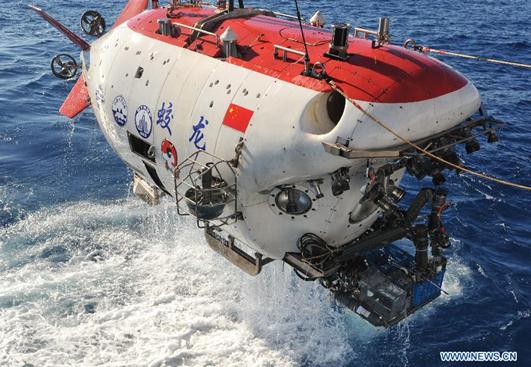

China's deep sea manned submersible Jiaolong is lifted out of water in the Indian Ocean, Jan. 2, 2015. Jiaolong carried out the first dive on a mission to study active hydrothermal vent in the southwestern Indian Ocean on Jan. 2. It was the first time for the submersible to take the second batch of pilot trainees in the diving, which was intended to enable the trainees to learn some skills of submersible operation in active hydrothermal vent and collect samples of hydrothermal fluid, sulfide, rocks, sediment and water. (Xinhua/Zhang Xudong)
China's deep-sea manned submersible Jiaolong took 300 milliliters of hydrothermal fluid in two active hydrothermal vents and other scientific samples at the seabed of southwestern Indian Ocean on Friday.
The temperature of one active hydrothermal vent, which Jiaolong measured with a special probe in its iron hand, was 352 degree Celsius, said Yu Hongjun, chief commander of the expedition.
"This is a big step for Jiaolong as this is the first time the submersible did it," said Yu.
Detailed information and samples that Jiaolong collected will be very important for China's future polymetallic sulfide study and other scientific research, said Tao Chunhui, chief scientist of the expedition.
Besides, Jiaolong gathered 1.8 kg of sulfide, 2.3 kg of basalt, 15 spiral shells, one stalked barnacle and 8 liters of deep-sea water in this dive.
"We saw that lots of active hydrothermal vents alternated with inactive ones in this area." said Fu Wentao, pilot of Jiaolong, who celebrated his 32nd birthday in the dive.
As the topography of the polymetallic sulfide area was complicated, it was very hard to find a proper place for the submersible to rest, Fu said.
"The temperature of active hydrothermal vents is more than 300 degree Celsius, so I must keep the submersible away from the vents but I also need to get the submersible as close as possible to the vents to measure the temperatures and get samples," Fu said.
Hydrothermal sulfide is a kind of sea-bed deposit containing copper, zinc and precious metals such as gold and silver. Those metals formed sulfides after chemical reactions and settled at the seabed in "chimney vents."
Being on a 120-day expedition in southwest Indian Ocean, Jiaolong is scheduled to dive 20 times to study polymetallic sulfides, biological diversity, hydrothermal microbes and genetic resources.
Copyright ©1999-2018
Chinanews.com. All rights reserved.
Reproduction in whole or in part without permission is prohibited.